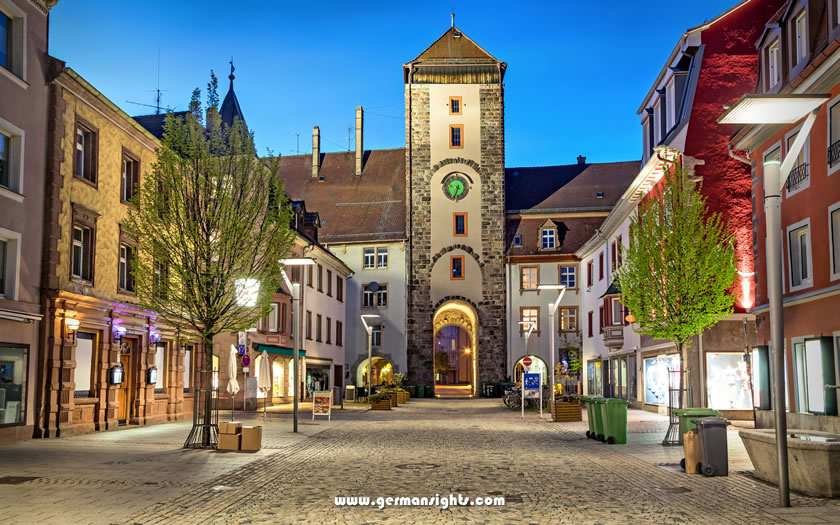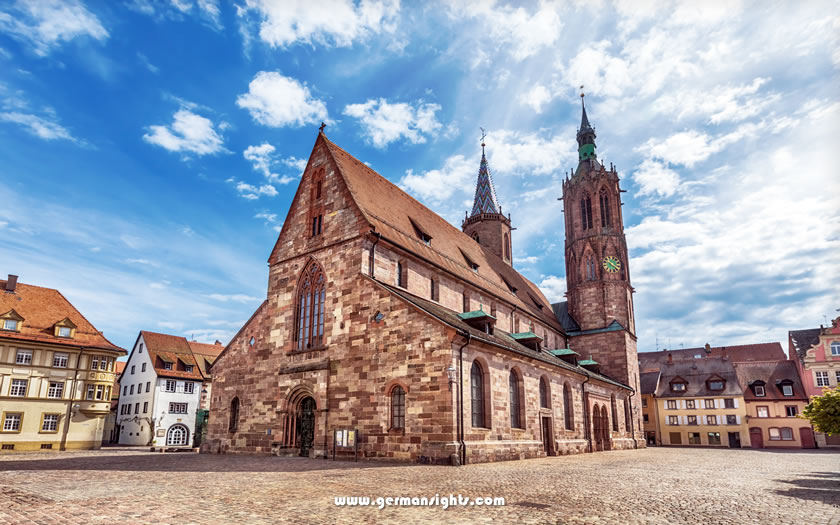Villingen-Schwenningen is a rather odd administrative 'town' created in 1972 near the eastern edge of the Black Forest in Baden-Württemberg which is made up of two very different communities.
Villingen is the more attractive of the two and thus the more popular with visitors to the area. It has a compact historic centre with plenty of sights from its origins in the original Grand DuchHistoryy of Baden.
Eight kilometres to the east, with a different telephone number and an industrial past, Schwenningen only became a town in the Kingdom of Württemberg at the start of the 20th century.

The Upper Gate of the old town walls in Villingen
Villingen-Schwenningen is pretty much equidistant to all the airports in the region. The best options from the point of view of choice and onward transport are probably Stuttgart and Zurich.
Distance to Zurich Airport: 92km
Distance to Stuttgart Airport: 114km
Distance to Friedrichshafen (Bodensee) Airport: 114km
Distance to Baden Airport: 120km
Distance to EuroAirport Basel-Mulhouse-Freiburg: 134km
The smaller airports at Friedrichshafen and Baden-Baden offer a more limited choice including some budget airlines, although the choice of carriers and destinations at the two closer airports is likely to be much greater.
Villingen is a stop on the main Schwarzwaldbahn (Black Forest Railway) between Offenburg and Singen (effectively Karlsruhe and Konstanz when linked services are taken into account).
It is also a stop on the regional service between Titisee-Neustadt, Donaueschingen and Rottweil, while the Ringzug rail service run by the Hohenzollerische Landesbahn links both Villingen and Schwenningen stations to Donaueschingen, Rottweil and Bräunlingen.
Villingen railway station is located a short walk outside the old town walls to the east, while Schwenningen train station is to the south of the main central square.
The two communities both lie to the west of the A81 motorway between Stuttgart and Lake Constance. There are also road links into the Black Forest centres of Triberg, Donaueschingen and Titisee.
For visitors and tourists, Villingen is by far the most popular of the two linked towns with its historic sights and the location on the main Black Forest rail route.
But Schwenningen is also linked to Villingen by rail and bus and is not much further away from the main sights in the region.
If you know when you are planning to go but haven't decided on accommodation, then use the map below to get an idea of which properties are available and to compare prices during the period you wish to travel.
Enter your proposed dates and use the '+' to zoom in on a location and reveal more properties. Click on the price above a property to see more information.
(Please note that this selection will also include some pensions and self-catering apartments for those who are interested in that form of accommodation!)
Alternatively, if you would like a list of properties available on your proposed dates of travel, use the search box below to find accommodation:
Villingen is by far the older of the two settlements, with remains of Stone Age villages having been found nearby.
Both Villingen and Schwenningen are first mentioned in the 9th century but three centuries on Villingen had received its town charter and become a Free Imperial City while Schwenningen remained a village.
Villingen was purchased by an Austrian count in the 14th century and remained part of Austria until the Napoleonic era. It came under siege a number of times during the wars of the Middle Ages but was not defeated until the War of the Spanish Succession in the 18th century.
Even then, the town was forced to open its gates by external circumstances and not by suffering a military defeat.

The Minster of Our Lady at Villingen
The remains of many of the defensive fortifications which protected the town are still visible, with the towers and town wall surrounding the current pedestrian area, town hall and minster.
With one of the treaties bringing a temporary peace during the Napoleonic wars, Villingen became part of the Kingdom of Württemberg. Only temporarily, however, as it was swapped with the Grand Duchy of Baden for other territory that the Kingdom desired.
Both Schwenningen and Villingen started a rapid expansion in population with new rail connections in the 19th century and increasing industrialisation. Schwenningen, in particular, became a centre for watchmaking with a number of important companies growing from their bases in the former village.
The two communities were joined by the administrative reform in Baden-Württemberg in the 1970s.
The tourist information office in Villingen is located on Rietstrasse near the Riettor tower in the Franciscan cultural and concert hall. It is open every day with slightly restricted hours on Sunday.
Tourist Office: www.villingen-schwenningen.de (German only)